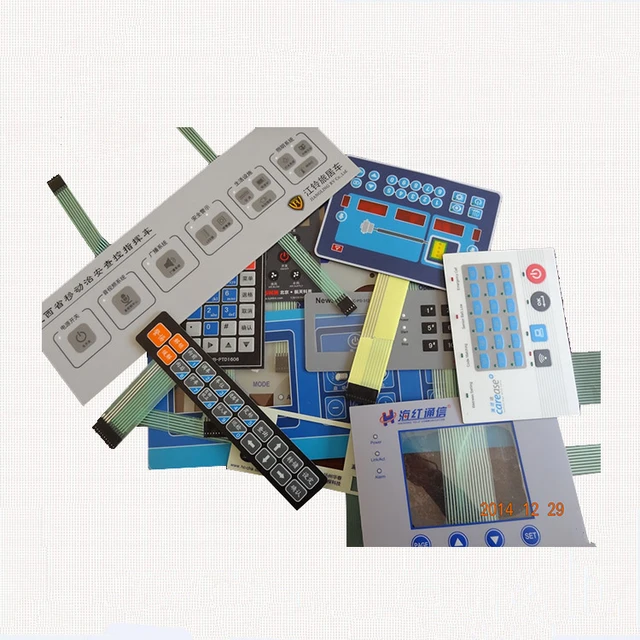The Role of Membrane Switches in Enhancing Device Functionality
The Role of Membrane Switches in Enhancing Device Functionality
Blog Article
Recognizing Membrane Switches: The Key to Resilient and Trustworthy Controls

What Are Membrane Layer Buttons?
Membrane buttons are an innovative solution in the realm of individual interface modern technology, integrating functionality and design flawlessly. These devices function as an interface between users and digital systems, incorporating a number of parts into a portable style. Normally built from flexible, slim layers of products, membrane buttons are designed to react to touch, making it possible for customers to interact with machinery and digital devices effectively.
The key elements of a membrane layer button include a printed circuit layer, graphic overlay, and a spacer layer that stops unintentional activation. The graphic overlay can be personalized to mirror brand name identification or customer preferences, enhancing looks while making sure usability. Membrane buttons are frequently utilized in different applications, consisting of medical devices, consumer electronics, and commercial equipment, owing to their resilience and resistance to environmental variables such as wetness and dust.
Among the crucial benefits of membrane layer switches is their capacity to endure deterioration, making them suitable for high-traffic atmospheres. Additionally, they are light-weight and need very little room, enabling for ingenious designs in product growth. Overall, membrane layer changes represent a useful and effective choice for modern digital interfaces, weding technology with user-centric layout concepts.
How Membrane Layer Switches Work
The procedure of membrane changes joints on a simple yet effective system that converts customer input into electronic signals. When an individual presses the switch, the leading layer flaws, enabling a conductive aspect in the circuit layer to make call with an equivalent conductive pad on the underside of the graphic overlay.
The design of membrane layer buttons can vary, however they frequently integrate domes or tactile aspects to give comments to the individual, boosting the total experience - membrane switch. The materials used in membrane switches, such as polyester or polycarbonate, add to their resilience and resistance to environmental elements, consisting of moisture and dirt. In addition, the printed circuits are generally enveloped, which shields them from deterioration over time.
Benefits of Membrane Layer Switches

In addition, membrane layer switches are understood for their resilience. Constructed from robust materials, they are resistant to dust, wetness, and physical wear, which significantly extends their lifespan compared to typical mechanical switches. This toughness makes them especially suitable for high-traffic environments and applications calling for long life.
One more significant advantage is the simplicity of cleansing and maintenance. The smooth surface of membrane layer changes decreases dust buildup and is frequently invulnerable to spills, making them suitable for settings that need constant sanitization.
Moreover, membrane layer switches offer a structured profile, leading to a thinner design that can be integrated right into various tools without adding bulk. This feature not only improves the visual allure however also contributes to a more ergonomic item style.
Applications of Membrane Layer Switches
Functional and user-friendly, membrane layer buttons find applications throughout a variety of sectors, consisting of clinical devices, consumer electronic devices, and commercial tools. In the clinical field, these buttons are important to gadgets such as diagnostic equipment, client surveillance systems, and mixture pumps, where dependability and simplicity of cleansing are critical. Their capacity to endure harsh atmospheres and maintain functionality makes them excellent for such applications.

In consumer electronics, membrane Bonuses buttons are used in items like microwaves, washing makers, and remote controls - membrane switch. Their sleek design enables for intuitive customer interfaces, enhancing the total user experience while supplying toughness and resistance to damage
Industrial tools additionally benefits from membrane buttons, especially in control panels for machinery and automation systems. These buttons supply protection versus dust and moisture, guaranteeing regular efficiency in tough settings. Moreover, their personalized attributes permit producers to tailor them to details functional requirements, boosting performance and functionality.
Picking the Right Membrane Switch Over
When choosing a membrane layer button, it is necessary to consider numerous aspects that influence performance and viability for specific applications. The key factors to consider consist of environmental conditions, tactile comments, resilience, and layout requirements.
First, evaluate the operating setting; buttons exposed to moisture, chemicals, or extreme temperature levels call for particular materials to make certain durability and functionality. Next off, examine the need for responsive comments. Depending on customer interaction, some applications might take advantage of a responsive action to verify activation, while others may favor a non-tactile style for visual factors.
Longevity is another important factor; membrane switches should be developed to withstand regular usage, effects, and abrasion. Ensure the selected switch can sustain the anticipated lifecycle, particularly in high-usage scenarios.

Conclusion
In final thought, membrane layer switches over serve as crucial components in the design of dependable and long lasting control systems throughout numerous industries. The convenience of membrane changes permits for customized solutions that fulfill details functional needs, reinforcing their importance in modern-day innovation.
Membrane changes stand for an important element of modern user interface layout, blending functionality with resilience in different applications.Membrane buttons are a sophisticated remedy in the realm of user interface technology, combining functionality and style seamlessly. Normally constructed from flexible, slim read the article layers of materials, membrane buttons are designed to react to touch, enabling customers to communicate with machinery and electronic tools effectively.
The style of membrane switches can differ, but they frequently integrate domes or responsive aspects to supply responses to the user, enhancing the total experience.In final thought, membrane layer switches offer as crucial components in the design of durable and trusted control systems throughout various sectors.
Report this page